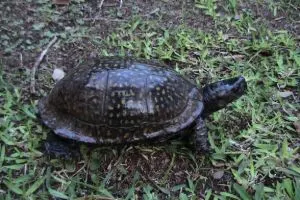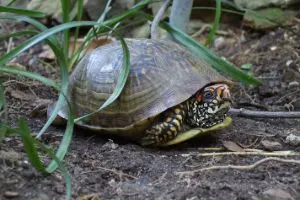Breeding Box turtles captively is much better than buying them from a pet store or catching them from the wild.
Since these chelonians are so popular and have been successfully bred several times by several breeders, there is a lot of information available on the subject.
Not only is breeding profitable but also it helps protect the wild population from exploitation. Before we start, here is some basic information on box turtles. Box turtles include all chelonians that made up the genus Terrapene.
These terrestrial turtles look like tortoises, however, they are members of the pond turtle family – Emydidae. For a successful breeding process, you need suitable mates, suitable nesting, and suitable incubation conditions.
Table Of Contents
Box Turtle Breeding Guide
1. Suitable Mates
Among turtles, sexual maturity is generally determined by size. Box turtles generally reach maturity between the ages of 7 and 10; and between the carapace lengths of 5 & 6 inches.
In addition to the size, it is essential that the female, in particular, is of optimal health. You can achieve this by maintaining the right living conditions. Not only should temperature and humidity levels be optimal, but the enclosure also needs to be clean and spacious.
Feed the turtles, especially the females, a diet rich in calcium and protein prior to the breeding season. As omnivorous turtles that lean heavily towards carnivorous, the diet of the female should be composed of about 40% plant matter and 60% protein.
Diets should be supplemented with high-quality vitamin and mineral supplements. The calcium to phosphorus ratio of the turtle’s diet should be 5:1, 4:1, or 3:1. High calcium diets help prevent egg binding also known as dystocia.
Matured lengths of some commonly bred box turtles include
Eastern box turtle (Terrapene carolina carolina)

- Length: 5 to 8 inches (12-20 cm)
- Learn more about the Eastern box turtle
Florida box turtle (Terrapene carolina bauri)

- Length: Adult female – 4.7 to 6.3 inches (12 to 16 cm), Adult male – 5 inches to 6.6 inches (13 to 17 cm)
- Learn more about the Florida Box Turtle
Gulf Coast box turtle (Terrapene carolina major)

- Length: 8 inches
Three-toed box turtle (Terrapene carolina triunguis)

- Length: 4.5 to 5 inches, with 7 inches being the record shell length
- Learn more about the 3 toed box turtle
Ornate box turtle or western box turtle

- Length: 4 to 6 inches (9.5 to 15 cm), an average of 4.72 in (12 cm)
- Weight: 7 to 19 oz (198 to 538 g), an average of 14 oz (398 g)
- Learn more about the ornate box turtle
2. Hibernation (Brumation)
For most North American turtles, hibernation (in this case brumation as turtles are reptiles) is necessary for successful breeding. Only healthy turtles should be allowed to brumate.
If you have an outdoor enclosure, you may want to hibernate the turtles outdoors or in a shed. However, you can also hibernate the turtles inside a refrigerator.
It isn’t the best idea to simply allow your box turtles to hibernate without supervision. You want them to be somewhere you can keep a close eye on them.
It’s advisable that you keep the turtles in a shed or any part of the house where temperatures fall before 50 °F such as an unheated crawl space, attic, or basement.
Box turtles aren’t aquatic turtles so water isn’t involved when it comes to setting up the hibernaculum ( hibernation box).
The box, which can be a wooden crate or cardboard box, should be large enough to accommodate the turtle and should be filled with about a foot of sand (40%) and topsoil (60%). Cover the mix with an equal amount of leaf litter.
For hibernation to occur, temperatures need to drop below 50 °F. Once the night time temperature is 50 °F and below, move the turtle into the hibernaculum and move the hibernaculum inside your shed or garage.
You will notice that the turtle is sedentary (not moving around much) prior to hibernation. If the chelonian is kept in an indoor terrarium, reduce the temperature within the room by 5 °F two weeks to hibernation.
Some keepers also encourage breeders to soak the turtle in a ¾ inch tepid water every two days for 30 minutes within the two weeks before hibernation.
This encourages the turtle to empty their bowels and improves hydration prior to hibernation. Similarly, stop feeding the turtle two weeks to hibernation.
You can also hibernate the turtle within a refrigerator. This method is best when you don’t have the needed space to store the hibernating reptiles.
Check on the hibernating chelonian at regular intervals. Signs that your turtle is unwell include refusal to hibernate and weight loss which is indicative of dehydration. During hibernation, a turtle shouldn’t lose more than 1% of its total body weight per month.
3. Courtship and mating
Mating usually occurs in early spring (around March and April), but can also happen any time after hibernation. The change in seasons induces mating behavior in box turtles.
You will notice that males get anxious to mate around this time. During the mating season, group turtles in separate containers according to size. This ensures that smaller turtles aren’t stressed unnecessarily.
During mating season, some breeders choose to expose females to males for just an hour a day since males can be quite aggressive. However, separating turtles by size should be enough in most cases. Having more females than males also helps control the stress that the females experience.
4. Creating a nesting area
Nesting among box turtles occurs in June and July. If you have just a single pair of turtles, you can create the nesting area with the female’s private enclosure. If not, then you need to create several nesting areas within the communal enclosure.
The female’s enclosure needs several nesting sites. These sites should be littered with a few logs and rocks as this ensures that the female feels safe. The nesting sites should be about a foot deep and filled with moist but not wet nesting substrate (about 60% topsoil and 40% sand).
Alternatively, gravid turtles can be placed in a box filled with about 12 inches of slightly moistened nesting substrate for about an hour each day. The room within which this box is placed should be dark with a single light source that hangs directly above the box.
5. Incubation
The gravid female lays a clutch size of 2 to 8 eggs, usually about just 2 to 4 eggs. 5 to 8 eggs per clutch is quite rare. The gravid female uses her hind legs to dig up a cavity.
Once she lays the eggs within the cavity, she carefully covers them up. This is done so expertly that it can be difficult to see where the eggs are buried with your naked eggs.
And you don’t want to agitate the eggs when collecting them as agitation can easily kill the fetus within the eggs. This can make the collection difficult.
You may need to carefully search for the eggs within the nest. Box turtle eggs are elliptical with thin flexible white shells that are about 30 mm long and 20 mm wide. Eggs laid above ground or in water are usually infertile eggs.
Although incubation takes about 90 days, the higher the temperature within the incubator, the shorter the incubation period. If the temperatures are high (80 to 84 °F) the incubation period is usually between 65 to 75 days.
Temperature
Temperature determines the sex of the hatchlings. Temperatures from 22 to 26 °C (72 to 79 °F) produce more males, and temperatures above 28 °C (82 °F) produce more females. A temperature of about 27 °C (80 °F) produces an even mix of males and females.
Regardless of the temperature you choose, it must be constant throughout the entire incubation process. If you choose 84 °F, the temperature within the incubator must be 84 °F from the start of incubation to the end of incubation.
Moisture levels
To prevent the egg from drying out, keep humidity levels at around 70 to 75%. The moisture level however should not be too high. To help maintain the right moisture level, lightly moisten the substrate used to incubate the egg.
Egg position and handling
Reptile eggs need to be handled with care. Turning the egg upside down or agitating it can kill the developing hatchling.
When digging through the nest for the eggs, you need to proceed with care.
When moving the eggs from the nest to the incubator, you need to maintain their orientation throughout the entire process.
6. Caring for newly hatched box turtles
Box turtles are precocial. As such, they are well developed at birth. They then process to grow at a rate of around half an inch every year during the next five years.
Don’t help hatchlings out of their shell unless it’s absolutely necessary. In fact, hatchlings should remain in their shells for up to a day (24 hours).
This allows them to absorb yolk which provides the newly hatched turtles with nourishment.
Hatchlings should be separated and kept in individual boxes as hatchlings can attempt to feed on one another. T. ornata hatchlings, in particular, are very aggressive.
Soak hatchlings that are free from their shells in shallow water (the water level shouldn’t be higher than half the distance between the bottom of the hatchling’s shell to their nostrils) for about an hour. This allows the turtle to drink.
Keep the individual hatchlings in plastic boxes. The substrate within the box should be slightly moister than the substrate within an adult enclosure is.
In terms of diet, feed hatchling more protein, about 70 to 75 percent protein. Supplement the diet with vitamin and calcium supplements. Feed hatchlings every day.
Keep the ambient temperature of the hatchling’s enclosure at 80 °F. The hotspot should have a temperature of 88 °F, give or take 2 °F. The cool end should have a temperature of 74 °F, give or take 2 °F.
Eastern Box Turtle Eggs Hatching
Conclusion
For a successful box turtle breeding process, the conditions need to be on point. To begin with, you need at least two suitable mates – mature box turtles of the same species (& even subspecies when necessary) and of the opposite sex.
It is, however, advisable to have more females than males. The nesting conditions also need to be within the right range if you want the gravid female to properly lay her eggs.
Lastly, the incubation conditions such as temperature and humidity need to be within the right ranges. An incubator is the easiest way to regulate the conditions.
If you have any extra information or questions, kindly leave a comment.
